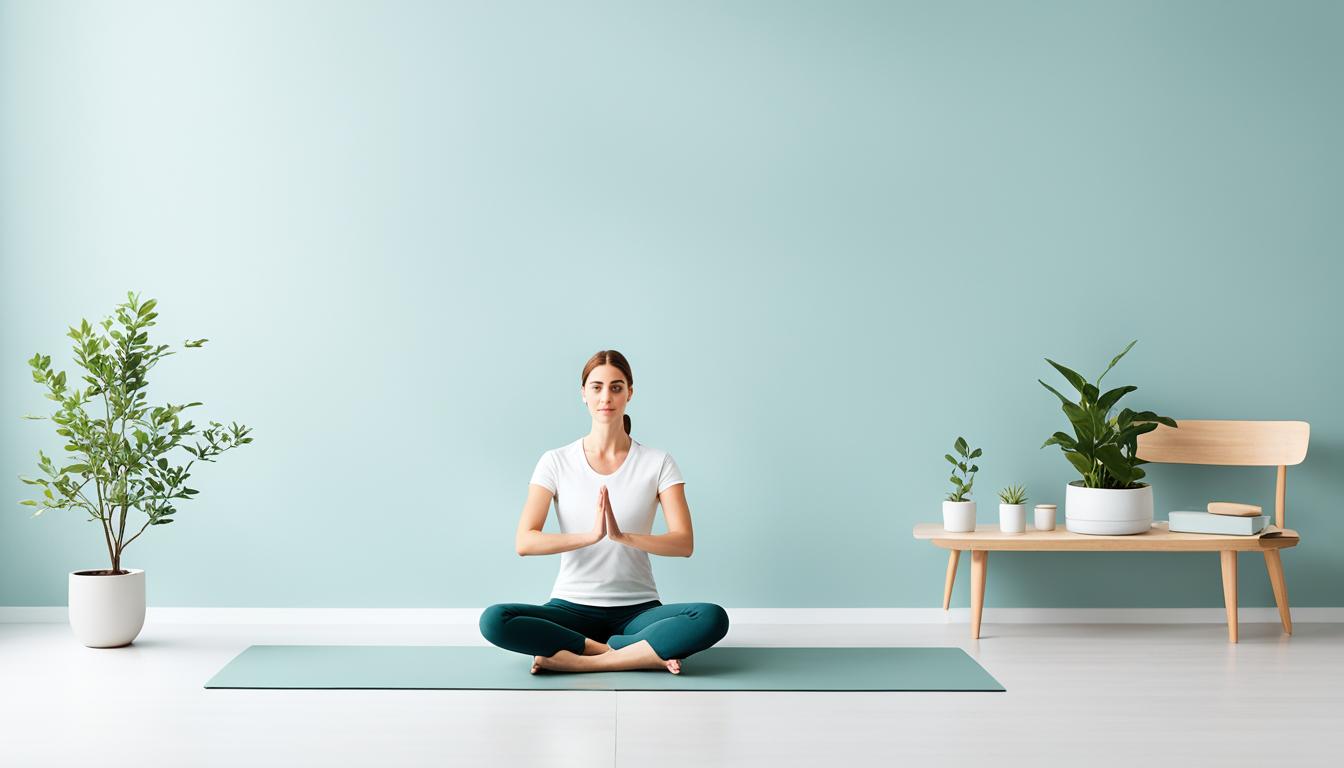“Do not let the behavior of others destroy your inner peace.” – Buddha
Life can be a whirlwind of emotions and unexpected events, often leaving us caught up in unnecessary drama. We find ourselves reacting to situations with heightened emotions, creating chaos and stress in our lives. But what if we could break free from this cycle? What if we could learn how to stop being dramatic and embrace calmness and serenity?
In Buddhism, there is a profound understanding of the human mind and the power it holds to either create or alleviate drama. By exploring the teachings and principles of Buddhism, we can discover transformative techniques and strategies that help us overcome drama and restore inner peace.
Key Takeaways:
- Understand the root causes of drama and the role of attachment and resistance in fueling it.
- Practice the art of letting go and accepting the present moment to cultivate inner peace.
- Use powerful mantras to shift your mindset and release negativity.
- Recognize the signs of drama and develop strategies to respond with calmness and neutrality.
- Embrace the practice of non-response and create space for stillness within.
Understanding the Root Causes of Drama
Do you often find yourself caught up in unnecessary drama? Wondering why situations escalate, causing stress and anxiety? Understanding the root causes of drama can help you address and overcome it. Let’s explore the factors that contribute to drama in our lives.
- Attachment to ideals: When we cling onto unrealistic expectations and ideals, we set ourselves up for disappointment. Our attachment to these ideals creates a gap between the reality and our expectations, leading to frustration and drama.
- Resistance to accepting reality: When things don’t go as planned or others fail to meet our expectations, we may resist accepting the situation as it is. This resistance fuels drama in our lives, as we struggle to let go of our desired outcomes.
- Blaming others for drama: It’s easy to point fingers and blame others for the drama we experience. However, this blame game only perpetuates the cycle of drama, leading to more conflicts and misunderstandings.
Image:

Recognizing these root causes can empower you to break free from the grips of drama. By letting go of attachment to ideals, accepting reality, and taking responsibility for your own reactions, you can cultivate a life with less drama and more peace.
| Causes of Drama | Effects |
|---|---|
| Attachment to ideals | Unrealistic expectations, frustration, conflicts |
| Resistance to accepting reality | Stress, anxiety, difficulty in problem-solving |
| Blaming others for drama | Escalation of conflicts, strained relationships |
By understanding the causes of drama, you can begin to take control of your reactions and create a more peaceful and harmonious life. In the next section, we will delve into practical techniques to let go of drama and embrace calm.
The Practice of Letting Go
Letting go of drama is not always easy, but with practice, it becomes a powerful tool for finding inner peace and embracing the present moment. By developing mindfulness and acceptance, you can release the negative emotions and stress that come with dramatic situations. Instead of getting caught up in the chaos, you can cultivate a sense of calmness and discover the fundamental goodness within yourself and in every situation.
When faced with stress and negative emotions, the key is to focus on your feelings and acknowledge them without judgment. Take a moment to breathe deeply, allowing your body to relax and your mind to become still. In this state of relaxation, you can find a quiet space within yourself, where you can let go of the drama and connect with the present moment.
During this practice of letting go, it is helpful to focus on the reality of the situation and embrace it without resistance. Rather than dwelling on what could have been or what should be, accept the present moment as it is. Acceptance does not mean you approve of or agree with everything that is happening; it simply means acknowledging the reality of the situation without trying to change it.
As you let go of drama, shift your focus to the goodness that exists within yourself and in your surroundings. Recognize the positive aspects of your challenges, relationships, and work. By reframing your perspective and embracing the reality in front of you, you can find inner peace and joy.
Practicing Mindfulness
Mindfulness is a powerful practice that complements letting go of drama. By cultivating present-moment awareness, you can stay grounded and centered, even in the midst of chaos. Mindfulness involves paying attention to your thoughts, feelings, and sensations without judgment.
- Practice deep breathing exercises to anchor yourself in the present moment.
- Engage in meditation or mindfulness activities to train your mind to stay focused and present.
- Observe your thoughts and emotions without getting attached to them. Let them come and go, like clouds passing in the sky.
- Embrace the power of stillness and silence, allowing yourself to fully experience the present moment without distractions.

By incorporating mindfulness into your daily life, you can develop a greater sense of clarity, peace, and resilience. It enables you to stay grounded, make conscious choices, and respond to challenging situations with wisdom and grace.
Mantras to Help Stop the Drama
To support the practice of letting go of drama, using mantras can be incredibly powerful. Mantras are positive affirmations or statements that can help shift our mindset and release negativity. By reframing our thoughts and embracing positive affirmations, we can let go of drama and cultivate a sense of calmness and peace.
Here are a few powerful mantras to help you stop the drama:
- “Needless drama doesn’t just walk into your life out of nowhere – you either create it, invite it, or associate with those who bring it.”
- “When you focus your heart and mind upon a purpose, and commit yourself to fulfill that purpose through small daily steps, positive energy floods into your life.”
These mantras serve as gentle reminders to let go of unnecessary drama, avoid judging others, and focus on personal growth and positivity. By repeating these mantras regularly, you can reframe your thoughts and release negativity, allowing space for peace and harmony in your life.

Recognizing Signs of Drama
It is crucial to be able to recognize the signs of drama in order to prevent it from escalating and causing unnecessary turmoil in your life. By being aware of these signs, you can approach situations with calmness and neutrality, avoiding unnecessary conflict and emotional distress.
Feeling Passionate and Emotionally Charged
One of the signs of drama is when you find yourself feeling intensely passionate and emotionally charged about a situation. This could manifest as anger, frustration, or even excessive excitement. It’s important to recognize these strong emotions and explore the underlying reasons behind them. Often, intense emotions can cloud our judgment and lead to impulsive and irrational reactions.
Inconsistency Between Words and Behavior
Another sign of drama is when there is inconsistency between what someone says and how they actually behave. Pay attention to whether individuals are making promises they don’t keep or displaying behavior that contradicts their words. Inconsistent words and behavior can indicate hidden agendas or a lack of genuine intention, contributing to drama in relationships and interactions.
A Sense of Urgency That May Not Be Warranted
Feeling a sense of urgency in certain situations is normal, but sometimes it can be a sign of unnecessary drama. If you find yourself constantly rushing, feeling pressured, or creating a sense of urgency around minor issues, it might be an indication that drama is at play. Taking a step back, evaluating the true urgency of a situation, and consciously choosing a calm and measured response can help diffuse unnecessary drama and maintain a sense of perspective.
By being aware of these signs of drama, you can proactively address situations and minimize their potential to escalate. Remember, maintaining a calm and composed mindset is key to navigating through drama with grace and resilience.

| Signs of Drama | Impact |
|---|---|
| Feeling passionate and emotionally charged | Can lead to impulsive reactions and clouded judgment |
| Inconsistency between words and behavior | Undermines trust and creates confusion |
| A sense of urgency that may not be warranted | Increases stress and escalates minor issues |
Practicing Non-Response to Drama
To cultivate a sense of calmness and inner peace, it is important to practice non-response to drama. Non-response involves being aware of your body sensations, thoughts, and emotions without getting caught up in them. By creating space and detaching from drama, you can find a deeper sense of tranquility and resilience.
Creating Space for Calmness
To create space and distance yourself from drama, start by consciously relaxing your body. Close your eyes, take a deep breath, and release any tension you may be holding. Soften your facial muscles and let go of any emotional or physical tightness. By consciously relaxing, you can create a sense of spaciousness within yourself, enabling you to observe drama without getting entangled in it.
Sitting with Discomfort
The practice of sitting with discomfort is a powerful tool in letting go of drama. When faced with challenging situations or emotions, resist the urge to react immediately. Instead, allow yourself to sit with the discomfort, observing it without judgment. By acknowledging and accepting the discomfort, you can gradually learn to respond to drama from a place of calmness and clarity.
Remember, non-response to drama is a practice that requires patience and self-awareness. By creating space and sitting with discomfort, you can cultivate a stillness within, allowing you to navigate life’s challenges with grace and serenity.
The Art of Surrender
When it comes to finding inner peace and reducing drama in our lives, surrendering control plays a crucial role. Surrendering control means letting go of our fear and attachment to specific outcomes, and instead, accepting what is and having faith that everything will be okay. It is about trusting in the universe and embracing the flow of life.
By recognizing our fear and questioning its validity, we can begin to loosen our grip on control. Often, our fear stems from a need for certainty and a desire to avoid uncertainty or discomfort. However, by acknowledging that uncertainty is a natural part of life, we can start to embrace the unknown with curiosity and openness.
One way to surrender control is by staying in our own business. Instead of trying to control external circumstances or the actions of others, we can focus on our own thoughts, feelings, and behaviors. By shifting our attention inward, we can find clarity and align our actions with our values.
Another aspect of surrendering control is considering the freedom that comes with it. When we release our need for control, we free ourselves from the burden of trying to manipulate every outcome. We open ourselves up to new possibilities and opportunities that we may not have considered before. Surrendering allows us to take action from a place of trust and openness, rather than from a place of fear and resistance.
Throughout this journey of surrender, it’s important to remember that surrender does not mean giving up or being passive. It is a mindful choice to let go of the need for control and embrace acceptance and trust in the universe. Surrendering control empowers us to navigate life’s challenges with grace and resilience, knowing that we have the wisdom and strength to handle whatever comes our way.
The Benefits of Surrendering Control
| Benefit | Description |
|---|---|
| Reduced Stress | Letting go of the need to control every outcome frees us from the constant stress and pressure of trying to manipulate our circumstances. |
| Inner Peace | By accepting what is and trusting in the flow of life, we can cultivate a sense of inner peace and serenity. |
| Increased Adaptability | Surrendering control allows us to be more flexible and adaptable in the face of change, enabling us to navigate challenges with greater ease. |
| Deeper Connections | When we let go of control and embrace trust, we can foster deeper connections with ourselves and others, creating more fulfilling relationships. |
| Freedom to Explore | By releasing the need for control, we open ourselves up to new possibilities and experiences, expanding our horizons and personal growth. |
Embracing the art of surrender is a transformative practice that allows us to find peace and harmony amidst life’s uncertainties. By surrendering control, letting go, accepting, and trusting in the universe, we can create a life filled with balance, joy, and fulfillment.
Conclusion
In conclusion, the journey towards embracing calm and letting go of drama is a transformative process that begins with self-discovery and mindfulness. By understanding the root causes of drama and adopting specific practices, we can reduce drama in our lives and find inner peace.
Through the practice of letting go, we can release our attachment to unrealistic expectations and ideals, accepting ourselves and reality as they are. Using supportive mantras and reframing our thoughts, we can shift our mindset, letting go of negativity and embracing positivity.
Recognizing the signs of drama allows us to approach situations with calmness, while cultivating the habit of non-response empowers us to detach from drama and find a sense of calmness, even in challenging circumstances. Surrendering control and trusting in the universe enables us to embrace the flow of life, taking action from a place of openness and acceptance.
By embracing the present moment and letting go of drama, we can unlock the inner peace that resides within us. This journey not only benefits our individual well-being but also contributes to a more harmonious and compassionate society. So, embark on this path of self-discovery, embrace calm, let go of drama, and find the inner peace that you deserve.
FAQ
How can I stop being dramatic?
To stop being dramatic, you can practice letting go of unrealistic expectations and accepting reality as it is. By focusing on the present moment, practicing mindfulness, and embracing the fundamental goodness within yourself and every situation, you can cultivate inner peace and reduce drama in your life.
What are the root causes of drama?
Drama can arise from our attachment to ideals that do not align with reality. When things do not go as planned or others fail to meet our expectations, we become stressed and anxious. Our resistance to accepting things as they are and our tendency to blame others fuel drama in our lives.
How do I let go of drama?
Letting go of drama involves practicing mindfulness and acceptance. When faced with stress and negative emotions, you can focus on your feelings, acknowledge them without judgment, and relax your body and mind through deep breathing. By letting go of drama and accepting the present moment, you can cultivate inner peace and joy.
Can mantras help me stop the drama?
Yes, using mantras can be helpful in letting go of drama. Mantras are positive affirmations or statements that can shift your mindset and help you let go of negativity. By repeating mantras such as “Needless drama doesn’t just walk into your life out of nowhere – you either create it, invite it, or associate with those who bring it” or “When you focus your heart and mind upon a purpose, and commit yourself to fulfill that purpose through small daily steps, positive energy floods into your life,” you can remind yourself to let go of drama, not judge others, and focus on positivity and personal growth.
What are the signs of drama?
Signs of drama can include feeling passionate and emotionally charged, witnessing inconsistency between words and behavior, and feeling a sense of urgency that may not be warranted. Recognizing these signs can help you step back and approach situations with calmness and neutrality.
How can I practice non-response to drama?
To practice non-response to drama, it is important to be aware of your body sensations, thoughts, and emotions and observe them without getting caught up in them. Creating space by consciously relaxing your body, focusing on your breath, and softening your facial muscles can help you detach from drama and cultivate a sense of calmness. Sitting with discomfort and resisting the urge to react to drama can be challenging but is a powerful practice in letting go.
What is the art of surrender?
The art of surrender involves letting go of fear and attachment to specific outcomes. It is about accepting what is and having faith that everything will be okay. By recognizing your fear and questioning its validity, staying in your own business, and considering the freedom that comes with surrender, you can shift from trying to control to embracing the flow of life.
How can I find inner peace and embrace calm?
Finding inner peace and embracing calm is a journey of self-discovery and mindfulness. By understanding the root causes of drama, practicing letting go, using supportive mantras, recognizing signs of drama, and cultivating non-response and surrender, you can reduce drama in your life and find inner peace. By embracing the present moment and accepting yourself and reality as they are, you can stop being dramatic and foster personal and societal harmony.

